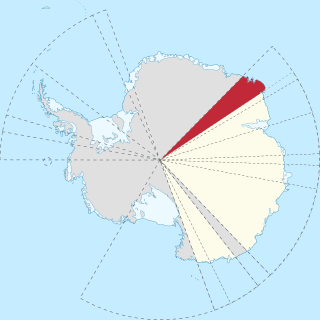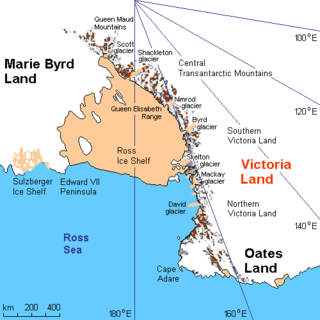
Lambert Glacier is a major glacier in East Antarctica. At about 80 km (50 mi) wide, over 400 km (250 mi) long, and about 2,500 m (8,200 ft) deep, it is the world's largest glacier. It drains 8% of the Antarctic ice sheet to the east and south of the Prince Charles Mountains and flows northward to the Amery Ice Shelf. It flows in part of Lambert Graben and exits the continent at Prydz Bay.
Mawson Escarpment is a flat-topped, west-facing escarpment which extends in a north–south direction for 110 km (70 mi) along the east side of Lambert Glacier in Antarctica. It was discovered by Flying Officer J. Seaton, Royal Australian Air Force, of the Australian National Antarctic Research Expeditions while on a reconnaissance flight in November 1956, and was named by the Antarctic Names Committee of Australia for Sir Douglas Mawson.

The Prince Charles Mountains are a major group of mountains in Mac. Robertson Land in Antarctica, including the Athos Range, the Porthos Range, and the Aramis Range. The highest peak is Mount Menzies, with a height of 3,228 m (10,591 ft). Other prominent peaks are Mount Izabelle and Mount Stinear. These mountains, together with other scattered peaks, form an arc about 420 km (260 mi) long, extending from the vicinity of Mount Starlight in the north to Goodspeed Nunataks in the south.
George V Coast is that portion of the coast of Antarctica lying between Point Alden, at 148°2′E, and Cape Hudson, at 153°45′E.
The Mawson Coast is that portion of the coast of Mac. Robertson Land, Antarctica, lying between William Scoresby Bay, at 59°34′E, and Murray Monolith, at 66°54′E. The coast was sighted during the British Australian New Zealand Antarctic Research Expedition (BANZARE), 1929–30, under Sir Douglas Mawson. Further exploration and landings at Cape Bruce and Scullin Monolith were made during BANZARE, 1930–31. Mawson Coast was named by the Antarctic Names Committee of Australia after Mawson in recognition of his great contribution to Antarctic exploration.
The Scott Mountains are a large number of isolated peaks lying south of Amundsen Bay in Enderby Land of East Antarctica, Antarctica. Discovered on 13 January 1930 by the British Australian New Zealand Antarctic Research Expedition (BANZARE) under Sir Douglas Mawson. He named the feature Scott Range after Captain Robert Falcon Scott, Royal Navy. The term mountains is considered more appropriate because of the isolation of its individual features.

Enderby Land is a projecting landmass of Antarctica. Its shore extends from Shinnan Glacier at about 67°55′S44°38′E to William Scoresby Bay at 67°24′S59°34′E, approximately 1⁄24 of the earth's longitude. It was first documented in western and eastern literature in February 1831 by John Biscoe aboard the whaling brig Tula, and named after the Enderby Brothers of London, the ship's owners who encouraged their captains to combine exploration with sealing.

English Coast is a portion of the coast of Antarctica between the northern tip of Rydberg Peninsula and the Buttress Nunataks, on the west side of Palmer Land. To the west is Bryan Coast, and northward runs Rymill Coast east of Alexander Island across George VI Sound. This coast was discovered and explored in 1940, on land by Finn Ronne and Carl R. Eklund and from the air by other members of the East Base of the US Antarctic Service (USAS), 1939–41. It was originally named "Robert English Coast" after Capt. Robert A.J. English, US Navy, Executive Secretary of USAS, 1939–41, and formerly Captain of the Bear of Oakland on the Byrd Antarctic Expedition, 1933–35. The name is shortened for the sake of brevity.
Eights Coast is a portion of the coast of West Antarctica, between Cape Waite and Pfrogner Point. To the west is the Walgreen Coast, and to the east is the Bryan Coast. It is part of Ellsworth Land and stretches between 103°24'W and 89°35'W. This coast is bordered by Thurston Island, Abbot Ice Shelf and some islands within the ice shelf, and for most of its length touches the Bellingshausen Sea. Most of Eights Coast is not claimed by any nation. In the east, Eights Coast borders the sector claimed by Chile as part of its southernmost province. Peter I Island, 450 kilometers north of the coast, is claimed by Norway as a dependency.

Oates Coast is the portion of the coast of Antarctica between Cape Hudson and Cape Williams. It forms the coast of Oates Land, part of the Australian claim to the Antarctic. The eastern portion of this coast was discovered in February 1911 by Lieutenant Harry Pennell, Royal Navy, commander of the expedition ship Terra Nova during the British Antarctic Expedition, 1910–13. He named the coast after Captain Lawrence E.G. Oates who, with Captain Robert F. Scott and three British Antarctic Expedition companions, perished on the return journey from the South Pole in 1912. Captain Oates' death was described by Robert Falcon Scott as "the act of a brave man and English gentleman". The western portion of the coast, the vicinity of the Mawson Peninsula, was first delineated from air photos taken by U.S. Navy Operation Highjump, 1946–47.
Athos Range is the northernmost range in the Prince Charles Mountains of Mac. Robertson Land, Antarctica. The range consists of many individual mountains and nunataks that trend east–west for 40 miles (64 km) along the north side of Scylla Glacier.
JOIDES Basin is a northeast trending undersea basin of the central Ross continental shelf. It was named for the "Joint Oceanographic Institutes Deep Earth Sampling" project, the name being approved by the Advisory Committee for Undersea Features in June 1988.
The Porthos Range is the second range south in the Prince Charles Mountains of Antarctica, extending for about 30 miles in an east-to-west direction between Scylla Glacier and Charybdis Glacier. First visited in December 1956 by the Australian National Antarctic Research Expeditions (ANARE) southern party under W.G. Bewsher (1956-57) and named after Porthos, a character in Alexandre Dumas, père's novel The Three Musketeers, the most popular book read on the southern journey.
On the continent of Antarctica, the Aramis Range is the third range south in the Prince Charles Mountains, situated 11 miles southeast of the Porthos Range and extending for about 30 miles in a southwest–northeast direction. It was first visited in January 1957 by Australian National Antarctic Research Expeditions (ANARE) southern party led by W.G. Bewsher, who named it for a character in Alexandre Dumas' novel The Three Musketeers, the most popular book read on the southern journey.

The Borchgrevink Coast is that portion of the coast of Victoria Land between Cape Adare and Cape Washington. The name was recommended by the New Zealand Antarctic Place-Names Committee in 1961 after Carsten Borchgrevink, a member of Henrik Johan Bull's expedition to this area, 1894–95, and leader of the British Antarctic Expedition, 1898–1900, the first to winter on the continent, at Cape Adare.
Belgrano Bank is an undersea bank in the Weddell Sea. It is named after General Manuel Belgrano, an Argentine general and revolutionary hero, after whom the main Argentine Antarctic base is also named. The name of the bank was approved by the Advisory Committee for Undersea Features in June, 1988.
Cave Bay is a 0.3-nautical-mile-wide (0.56 km) cove indenting the west side of Heard Island, an uninhabited Australian overseas territory in the Indian Ocean, between West Bay and South West Bay. The bay was formed by the erosion of an extinct volcanic crater of which Mount Andree forms the north side.
Mawson Corridor is a sea passage between grounded icebergs on the approach to Mawson Station at Holme Bay, Antarctica. It is about 22 nautical miles (41 km) long and 4 to 5 nautical miles wide, opening out at the southern end to give the feature a funnel shape. The northern end at 66°45′S 63°20′E is sharply defined and coincides with the edge of the continental shelf; from there it bears 202°. The passage was discovered by the Australian National Antarctic Research Expeditions (ANARE) in 1954, and was used regularly by ANARE relief ships in their approach to Mawson Station.

The Lassiter Coast is the portion of the east coast of the Antarctic Peninsula that extends from Cape Mackintosh to Cape Adams. The northern portion of this coast was discovered and photographed from the air by the United States Antarctic Service in 1940. During 1947 the entire extent of the coast was photographed from the air by the Ronne Antarctic Research Expedition (RARE) under Finn Ronne, who in conjunction with the Falkland Islands Dependencies Survey charted it from the ground.
Leslie Peak is a rock outcrop with a conical peak at its south end, about 5 nautical miles (9 km) south of Mount Cook of the Leckie Range, Antarctica. It was plotted from Australian National Antarctic Research Expeditions air photos, and was named by the Antarctic Names Committee of Australia for Leslie Miller, a radio officer at Mawson Station in 1964, and a member of one of the survey parties which carried out a tellurometer traverse passing through the Leckie Range in 1965.








